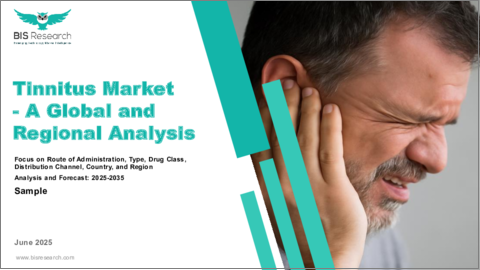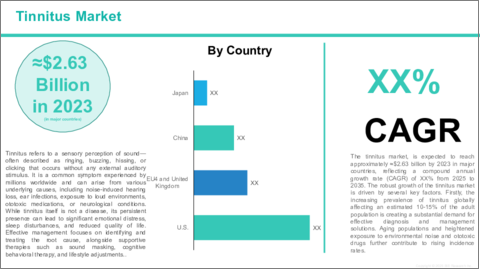|
|
市場調査レポート
商品コード
1753874
耳鳴り市場 - 世界および地域別分析:投与経路別、タイプ別、薬剤クラス別、流通チャネル別、国別、地域別 - 分析と予測(2025年~2035年)Tinnitus Market - A Global and Regional Analysis: Focus on Route of Administration, Type, Drug Class, Distribution Channel, Country, and Region - Analysis and Forecast, 2025-2035 |
||||||
カスタマイズ可能
|
|||||||
| 耳鳴り市場 - 世界および地域別分析:投与経路別、タイプ別、薬剤クラス別、流通チャネル別、国別、地域別 - 分析と予測(2025年~2035年) |
|
出版日: 2025年06月23日
発行: BIS Research
ページ情報: 英文 120 Pages
納期: 1~5営業日
|
- 全表示
- 概要
- 図表
- 目次
耳鳴りは、外部音源がないのに耳や頭でリンリン、ブーン、ヒューヒュー、カチカチといった音を感じることを特徴とする症状です。
耳鳴りは病気というよりむしろ症状であり、難聴、大きな騒音への暴露、耳の感染症、神経障害など、さまざまな根本的原因から生じる可能性があります。耳鳴りは多くの場合、断続的で軽いものですが、慢性的で重篤な場合もあり、苦痛、睡眠障害、集中困難などを引き起こすことで、個人の生活の質に大きな影響を与えます。管理は通常、根本的な原因への対処と、サウンドマスキング、認知行動療法、場合によっては薬物療法などの治療による症状の緩和に重点を置きます。
耳鳴り市場の主な促進要因の1つは、世界の人口の高齢化と、騒音公害、耳毒性のある薬物、生活習慣に関連した健康状態などの危険因子にさらされる機会の増加によって、世界的に耳鳴りの有病率が上昇していることです。このような患者数の増加は、効果的な診断ツールや治療オプションに対する大きな需要を生み出しています。さらに、神経調節装置や個別化音響療法の開発を含む技術の進歩が、認知度の向上やヘルスケアサービスへのアクセスの改善とともに、市場の成長をさらに後押ししています。これらの要因が相まって技術革新が促進され、市場の裾野が広がっているため、耳鳴り管理はヘルスケアにおける優先事項となっています。
耳鳴り市場の成長にもかかわらず、その可能性を十分に発揮するのを妨げる課題がいくつか残っています。主な課題の1つは、耳鳴りに特化した医薬品がFDAに承認されていないことで、治療の選択肢が制限され、根本的な原因ではなく関連症状を管理する適応外使用に頼らざるを得ないことが多いです。さらに、耳鳴りは根本的な原因や症状の現れ方が多様で、非常に主観的な症状であるため、診断や標準化された治療が困難です。耳鳴りは慢性的であり、利用可能な治療法の効果も様々であるため、患者のコンプライアンスは低いです。さらに、耳鳴りに対する社会的烙印や認知度の低さが、過少申告や受診の遅れにつながっています。最後に、高度な診断ツールや新しい治療機器に関連する高額な費用は、特に低・中所得地域において、治療の利用を制限する可能性があります。これらの課題に対処することは、市場の成長を維持し、患者の転帰を改善する上で極めて重要です。
世界の耳鳴り市場は競争が激しく、複数の主要企業が診断、治療、患者ケアの進歩に極めて重要な役割を果たしています。Mallinckrodt plc、Sun Pharmaceutical Industries Ltd.、Novartis AG、Endo Pharmaceuticals plcなどの企業は、耳鳴りの症状管理に適応外使用される中枢神経系薬剤の広範なポートフォリオを通じて大きく貢献しています。Zydus Group、Teva Pharmaceutical Industries Ltd、Aurobindo Pharmaなどのジェネリック医薬品大手は、新興市場で入手しやすい価格の医薬品を提供しています。GSK plc、Sandoz International GmbH、Pfizer Inc.、AstraZeneca、Sanofiなどの大手製薬会社は、耳鳴りの心理学的・神経学的側面をターゲットにした革新的な中枢神経系治療薬で市場を支えています。これらの企業は共に技術革新を推進し、治療法の選択肢を広げ、この複雑で発展途上の市場における患者の転帰の改善に取り組んでいます。
市場セグメンテーション
セグメンテーション1:タイプ別
- 主観的耳鳴り
- 客観的耳鳴り
- 感覚性耳鳴り
- 体性耳鳴り
- その他
セグメンテーション2:薬剤クラス別
- 抗うつ薬
- ベンゾジアゼピン
- コルチコステロイド
- プロスタグランジンアナログ
- その他
セグメンテーション3:投与経路別
- 経口
- 静脈内投与
- その他
セグメンテーション4:流通チャネル別
- 病院薬局
- 小売薬局
- オンライン薬局
セグメンテーション5:地域別
- 北米
- 欧州
- アジア太平洋
世界の耳鳴り市場には、治療の将来を大きく形作るいくつかの重要な新興動向が見られます。最も顕著な動向の1つは、薬理学的治療と音響療法、認知行動療法(CBT)、神経調節装置などの非薬理学的アプローチを組み合わせたマルチモーダル療法の統合が進んでいることです。この包括的なアプローチは、聴覚症状と関連する心理的苦痛の両方を対象とすることで、耳鳴りの多面的な性質に対処し、患者の転帰の改善につながります。
さらに、個別化医療の進歩により、個々の患者のニーズに合った治療計画が可能になりつつあります。これらの動向は、より全体的で患者中心のケアモデルへのシフトを反映しており、今後数年間の技術革新と市場成長の原動力になると予想されます。
当レポートでは、世界の耳鳴り市場について調査し、市場の概要とともに、投与経路別、タイプ別、薬剤クラス別、流通チャネル別、国別、地域別の動向、および市場に参入する企業のプロファイルなどを提供しています。
目次
エグゼクティブサマリー
第1章 世界の耳鳴り市場:業界展望
- イントロダクション
- 市場動向
- 規制の枠組み
- 疫学分析
- 臨床試験分析
- 市場力学
- 影響分析
- 市場の促進要因
- 市場の課題
- 市場の機会
第2章 世界の耳鳴り市場(投与経路別)、2023年~2035年
- 経口
- 静脈内
- その他
第3章 世界の耳鳴り市場(流通チャネル別)、2023年~2035年
- 病院薬局
- 小売薬局
- オンライン薬局
第4章 世界の耳鳴り市場(タイプ別)、2023年~2035年
- 主観的耳鳴り
- 客観的耳鳴り
- 感覚性耳鳴り
- 体性耳鳴り
- その他
第5章 世界の耳鳴り市場(薬剤クラス別)、2023年~2035年
- 抗うつ薬
- ベンゾジアゼピン
- コルチコステロイド
- プロスタグランジン類似体
- その他
第6章 世界の耳鳴り市場(地域別)、2023年~2035年
- 北米
- 欧州
- アジア太平洋
第7章 世界の耳鳴り市場:競合情勢と企業プロファイル
- 主要戦略と開発
- 合併と買収
- 相乗効果のある活動
- 事業拡大と資金調達
- 製品の発売と承認
- その他の活動
- 企業プロファイル
- Mallinckrodt plc
- Sun Pharmaceutical Industries Ltd.
- Novartis AG
- Endo Pharmaceuticals plc
- Zydus Group
- Pfizer Inc.
- Teva Pharmaceutical Industries Ltd
- Aurobindo Pharma
- GSK plc
- Sanofi
- Merck KGaA
- Sandoz International GmbH
- AstraZeneca
- Bayer AG
第8章 調査手法
List of Figures
- Figure: Global Tinnitus Market (by Region), $Million, 2024 and 2035
- Figure: Global Tinnitus Market Key Trends, Analysis
List of Tables
- Table: Global Tinnitus Market Dynamics, Impact Analysis
- Table: Global Tinnitus Market (by Region), $Million, 2024-2035
- Table: Global Tinnitus Market (by Route of Administration), $Million, 2024-2035
- Table: Global Tinnitus Market (by Distribution Channel), $Million, 2024-2035
- Table: Global Tinnitus Market (by Type), $Million, 2024-2035
- Table: Global Tinnitus Market (by Drug Class), $Million, 2024-2035
Global Tinnitus Market, Analysis and Forecast: 2025-2035
Tinnitus is a condition characterized by the perception of sound such as ringing, buzzing, hissing, or clicking in the ears or head without an external sound source. It is a symptom rather than a disease itself and can result from various underlying causes including hearing loss, exposure to loud noise, ear infections, or neurological disorders. While often intermittent and mild, tinnitus can be chronic and severe, significantly affecting an individual's quality of life by causing distress, sleep disturbances, and difficulty concentrating. Management typically focuses on addressing the underlying cause and alleviating symptoms through therapies such as sound masking, cognitive behavioural therapy, and in some cases, medication.
One of the key drivers of the tinnitus market is the rising prevalence of tinnitus worldwide, fuelled by an aging global population and increased exposure to risk factors such as noise pollution, ototoxic medications, and lifestyle-related health conditions. This growing patient base is creating substantial demand for effective diagnostic tools and treatment options. Additionally, advancements in technology, including the development of neuromodulation devices and personalized sound therapy, alongside increased awareness and better access to healthcare services, are further propelling market growth. These factors combined are driving innovation and expanding the market's reach, making tinnitus management a priority in healthcare.
Despite the growth of the tinnitus market, several challenges persist that hinder its full potential. One major challenge is the lack of FDA-approved medications specifically targeting tinnitus, which limits treatment options and often forces reliance on off-label use of drugs that manage associated symptoms rather than the root cause. Additionally, tinnitus is a highly subjective condition with diverse underlying causes and symptom presentations, making diagnosis and standardized treatment difficult. Patient compliance can be low due to the chronic nature of tinnitus and the variable effectiveness of available therapies. Furthermore, social stigma and limited awareness about tinnitus contribute to underreporting and delayed care-seeking behaviour. Lastly, high costs associated with advanced diagnostic tools and novel treatment devices can restrict access, especially in low- and middle-income regions. Addressing these challenges is crucial for sustaining market growth and improving patient outcomes.
The global tinnitus market is highly competitive, with several leading pharmaceutical companies playing a pivotal role in advancing diagnosis, treatment, and patient care. Companies such as Mallinckrodt plc, Sun Pharmaceutical Industries Ltd., Novartis AG, and Endo Pharmaceuticals plc contribute significantly through their extensive portfolios of CNS drugs used off-label for tinnitus symptom management. Generics leaders such as Zydus Group, Teva Pharmaceutical Industries Ltd, and Aurobindo Pharma provide affordable medications that enhance accessibility in emerging markets. Established pharmaceutical giants including GSK plc, Sandoz International GmbH, Pfizer Inc., AstraZeneca, and Sanofi support the market with innovative CNS therapies targeting the psychological and neurological aspects of tinnitus. Together, these companies drive innovation, expand therapeutic options, and work to improve patient outcomes in this complex and evolving market.
Market Segmentation:
Segmentation 1: by Type
- Subjective Tinnitus
- Objective Tinnitus
- Sensory Tinnitus
- Somatic Tinnitus
- Others
Segmentation 2: by Drug Class
- Antidepressants
- Benzodiazepine
- Corticosteroid
- Prostaglandin Analogues
- Others
Segmentation 3: by Route of Administration
- Oral
- Intravenous
- Others
Segmentation 4: by Distribution Channel
- Hospital Pharmacy
- Retail Pharmacy
- Online Pharmacy
Segmentation 5: by Region
- North America
- Europe
- Asia-Pacific
The global tinnitus market is experiencing several key emerging trends that are significantly shaping the future of treatment. One of the most prominent trends is the increasing integration of multimodal therapies, which combine pharmacological treatments with non-pharmacological approaches such as sound therapy, cognitive behavioural therapy (CBT), and neuromodulation devices. This comprehensive approach addresses the multifaceted nature of tinnitus by targeting both the auditory symptoms and the associated psychological distress, leading to improved patient outcomes.
Additionally, advancements in personalized medicine are enabling tailored treatment plans that better meet individual patient needs. These trends reflect a shift towards more holistic, patient-centred care models that are expected to drive innovation and market growth in the coming years.
Table of Contents
Executive Summary
Scope and Definition
Market/Product Definition
Inclusion and Exclusion
Key Questions Answered
Analysis and Forecast Note
1. Global Tinnitus Market: Industry Outlook
- 1.1 Introduction
- 1.2 Market Trends
- 1.3 Regulatory Framework
- 1.4 Epidemiology Analysis
- 1.5 Clinical Trial Analysis
- 1.6 Market Dynamics
- 1.6.1 Impact Analysis
- 1.6.2 Market Drivers
- 1.6.3 Market Challenges
- 1.6.4 Market Opportunities
2. Global Tinnitus Market (by Route of Administration), ($Million), 2023-2035
- 2.1 Oral
- 2.2 Intravenous
- 2.3 Others
3. Global Tinnitus Market (by Distribution Channel), ($Million), 2023-2035
- 3.1 Hospital Pharmacy
- 3.2 Retail Pharmacy
- 3.3 Online Pharmacy
4. Global Tinnitus Market (by Type), ($Million), 2023-2035
- 4.1 Subjective Tinnitus
- 4.2 Objective Tinnitus
- 4.3 Sensory Tinnitus
- 4.4 Somatic Tinnitus
- 4.5 Others
5. Global Tinnitus Market (by Drug Class), ($Million), 2023-2035
- 5.1 Antidepressants
- 5.2 Benzodiazepine
- 5.3 Corticosteroid
- 5.4 Prostaglandin Analogues
- 5.5 Others
6. Global Tinnitus Market (by Region), ($Million), 2023-2035
- 6.1 North America
- 6.1.1 Key Findings
- 6.1.2 Market Dynamics
- 6.1.3 Market Sizing and Forecast
- 6.1.3.1 North America Tinnitus Market, by Country
- 6.1.3.1.1 U.S.
- 6.1.3.1 North America Tinnitus Market, by Country
- 6.2 Europe
- 6.2.1 Key Findings
- 6.2.2 Market Dynamics
- 6.2.3 Market Sizing and Forecast
- 6.2.3.1 Europe Tinnitus Market, by Country
- 6.2.3.1.1 Germany
- 6.2.3.1.2 U.K.
- 6.2.3.1.3 France
- 6.2.3.1.4 Italy
- 6.2.3.1 Europe Tinnitus Market, by Country
- 6.3 Asia Pacific
- 6.3.1 Key Findings
- 6.3.2 Market Dynamics
- 6.3.3 Market Sizing and Forecast
- 6.3.3.1 Asia Pacific Tinnitus Market, by Country
- 6.3.3.1.1 China
- 6.3.3.1.2 Japan
- 6.3.3.1 Asia Pacific Tinnitus Market, by Country
7. Global Tinnitus Market: Competitive Landscape and Company Profiles
- 7.1 Key Strategies and Development
- 7.1.1 Mergers and Acquisitions
- 7.1.2 Synergistic Activities
- 7.1.3 Business Expansions and Funding
- 7.1.4 Product Launches and Approvals
- 7.1.5 Other Activities
- 7.2 Company Profiles
- 7.2.1 Mallinckrodt plc
- 7.2.1.1 Overview
- 7.2.1.2 Top Products / Product Portfolio
- 7.2.1.3 Top Competitors
- 7.2.1.4 Target Customers/End-Users
- 7.2.1.5 Key Personnel
- 7.2.1.6 Analyst View
- 7.2.2 Sun Pharmaceutical Industries Ltd.
- 7.2.2.1 Overview
- 7.2.2.2 Top Products / Product Portfolio
- 7.2.2.3 Top Competitors
- 7.2.2.4 Target Customers/End-Users
- 7.2.2.5 Key Personnel
- 7.2.2.6 Analyst View
- 7.2.3 Novartis AG
- 7.2.3.1 Overview
- 7.2.3.2 Top Products / Product Portfolio
- 7.2.3.3 Top Competitors
- 7.2.3.4 Target Customers/End-Users
- 7.2.3.5 Key Personnel
- 7.2.3.6 Analyst View
- 7.2.4 Endo Pharmaceuticals plc
- 7.2.4.1 Overview
- 7.2.4.2 Top Products / Product Portfolio
- 7.2.4.3 Top Competitors
- 7.2.4.4 Target Customers/End-Users
- 7.2.4.5 Key Personnel
- 7.2.4.6 Analyst View
- 7.2.5 Zydus Group
- 7.2.5.1 Overview
- 7.2.5.2 Top Products / Product Portfolio
- 7.2.5.3 Top Competitors
- 7.2.5.4 Target Customers/End-Users
- 7.2.5.5 Key Personnel
- 7.2.5.6 Analyst View
- 7.2.6 Pfizer Inc.
- 7.2.6.1 Overview
- 7.2.6.2 Top Products / Product Portfolio
- 7.2.6.3 Top Competitors
- 7.2.6.4 Target Customers/End-Users
- 7.2.6.5 Key Personnel
- 7.2.6.6 Analyst View
- 7.2.7 Teva Pharmaceutical Industries Ltd
- 7.2.7.1 Overview
- 7.2.7.2 Top Products / Product Portfolio
- 7.2.7.3 Top Competitors
- 7.2.7.4 Target Customers/End-Users
- 7.2.7.5 Key Personnel
- 7.2.7.6 Analyst View
- 7.2.8 Aurobindo Pharma
- 7.2.8.1 Overview
- 7.2.8.2 Top Products / Product Portfolio
- 7.2.8.3 Top Competitors
- 7.2.8.4 Target Customers/End-Users
- 7.2.8.5 Key Personnel
- 7.2.8.6 Analyst View
- 7.2.9 GSK plc
- 7.2.9.1 Overview
- 7.2.9.2 Top Products / Product Portfolio
- 7.2.9.3 Top Competitors
- 7.2.9.4 Target Customers/End-Users
- 7.2.9.5 Key Personnel
- 7.2.9.6 Analyst View
- 7.2.10 Sanofi
- 7.2.10.1 Overview
- 7.2.10.2 Top Products / Product Portfolio
- 7.2.10.3 Top Competitors
- 7.2.10.4 Target Customers/End-Users
- 7.2.10.5 Key Personnel
- 7.2.10.6 Analyst View
- 7.2.11 Merck KGaA
- 7.2.11.1 Overview
- 7.2.11.2 Top Products / Product Portfolio
- 7.2.11.3 Top Competitors
- 7.2.11.4 Target Customers/End-Users
- 7.2.11.5 Key Personnel
- 7.2.11.6 Analyst View
- 7.2.12 Sandoz International GmbH
- 7.2.12.1 Overview
- 7.2.12.2 Top Products / Product Portfolio
- 7.2.12.3 Top Competitors
- 7.2.12.4 Target Customers/End-Users
- 7.2.12.5 Key Personnel
- 7.2.12.6 Analyst View
- 7.2.13 AstraZeneca
- 7.2.13.1 Overview
- 7.2.13.2 Top Products / Product Portfolio
- 7.2.13.3 Top Competitors
- 7.2.13.4 Target Customers/End-Users
- 7.2.13.5 Key Personnel
- 7.2.13.6 Analyst View
- 7.2.14 Bayer AG
- 7.2.14.1 Overview
- 7.2.14.2 Top Products / Product Portfolio
- 7.2.14.3 Top Competitors
- 7.2.14.4 Target Customers/End-Users
- 7.2.14.5 Key Personnel
- 7.2.14.6 Analyst View
- 7.2.1 Mallinckrodt plc






